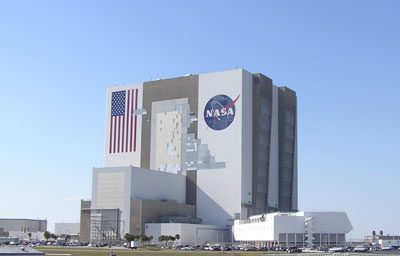Space Coast space ghostsby Dwayne Day
|
| These repeated bust cycles have hopefully made the area a little better able to handle the economic hit that will come with the end of the shuttle program. |
Beyond the job losses, there are other related issues. With human spaceflight gone from the Space Coast, what happens to property values in Cocoa Beach and surrounding areas? Thousands of people will lose their jobs and may no longer be able to pay their mortgages. They may have to move to places that have jobs, selling their homes at reduced rates. This has happened in the aerospace business before. Edwards Air Force Base used to have a brisk test flight business in the 1950s and 1960s, but when it dried up, the surrounding communities took a severe economic hit. Many homes were simply abandoned, left to the banks, and some neighborhoods never recovered. Could this happen in the Cape area?
Actually, it has.
The two largest communities adjacent to Cape Canaveral, the Kennedy Space Center, and Patrick Air Force Base, are Titusville and the City of Cocoa Beach. Ever since the Second World War, the two communities have seen several boom and bust cycles. According to Lori Walters, who wrote a history of Cocoa Beach’s relationship to the space program titled “Missileland, USA,” during the late 1950s and throughout the 1960s both communities expanded substantially as space and missile workers and their families moved into the region to support the Apollo and other programs that then flourished. Brevard County officials were so focused on providing new facilities to a booming population that they made no effort to diversify the economic base. By 1969 84 percent of the jobs in the county were directly or indirectly connected to the launch site. But by 1973, major job losses hit the region, and many people left, giving up their homes for the cost of the mortgage, or abandoning them altogether. Despite this, according to Walters, the situation in Cocoa Beach was never as bad as out-of-state newspapers portrayed it, and the city never became the “ghost town” that some reporters claimed it was. Still, times were tough.
Over the next several decades, Cocoa Beach in particular started to diversify and gentrify. Beach tourism and retirement communities emerged, so that the local economy was no longer as reliant upon space and missile jobs as before. The economy still took some hits, particularly after the Challenger accident brought the Titusville area to the brink of economic collapse, according to Walters. But in general it became more robust, and these repeated bust cycles have hopefully made the area a little better able to handle the economic hit that will come with the end of the shuttle program.
Kennedy is heading for a time when many jobs and operations will simply vanish, and many buildings will be closed up. NASA will face a difficult facilities management challenge, because the harsh Florida weather means that a building where the air conditioning is shut off becomes virtually unlivable within a relatively short period. Nobody will want the job of removing the mold from the VAB after it has been closed up for a decade. As a result, KSC officials are already planning on how to prevent the coming change from turning the center into a ghost town. Hopefully the local officials in the communities around the Cape are doing the same.
